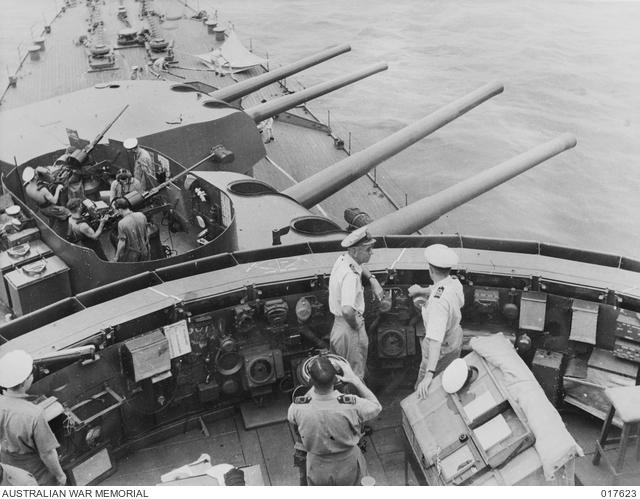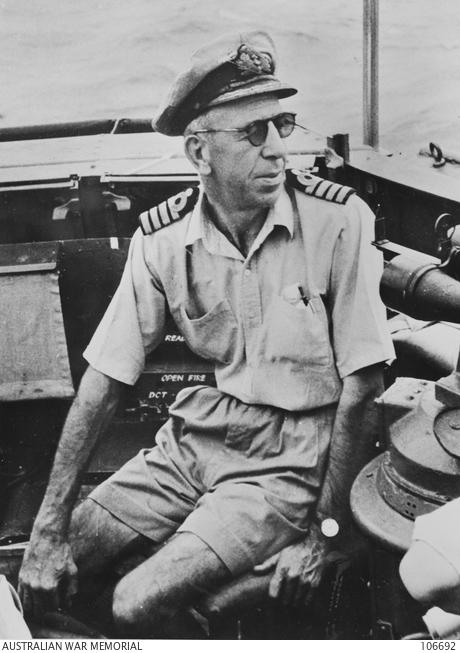The first Kamikaze attack?
“People of the Philippines, I have returned”, declared General Douglas MacArthur as he waded ashore at Beach Red in the Leyte Gulf in the afternoon of 20 October 1944, thus fulfilling the promise he had made two and a half years earlier after he was ordered by his President to leave.

Captain Dechaineux on the bridge of HMAS Australia in September 1944. C358774
On the same day Admiral Onishi Takajiro announced the formation of a new special attack unit (tokkotai) to support the Japanese plan for a decisive battle for the Philippines. The unit was to adopt the suicide tactics soon to become better known as kamikaze attacks. A massive raid at Formosa eight days earlier by a US task force and bombers from China had destroyed a large part of what remained of the Japanese navy’s aircraft. This had prompted the Emperor to send Onishi to the Philippines to organise tokkotai to carry out suicide attacks against Allied ships.
The Leyte Gulf invasion by the Allies to recapture the Philippines, which began on 20 October 1944, remains the largest single RAN operation ever undertaken. Among the 550 ships of the invasion fleets were the heavy cruisers Australia and Shropshire, the destroyers Arunta and Warramunga, and the landing ships Kanimbla, Manoora, and Westralia.
On the morning of 21 October, Trafalgar Day, a Japanese Val dive bomber suddenly appeared between Shropshire and Australia. Australia had just weighed anchor, making ready to provide fire support for the Americans ashore. Captain Nichols in Shropshire reports what happened next:
During the dawn stand-to a low aircraft approached from the land between Australia and Shropshire. It was taken under fire and retired to the westward. Observers in Shropshire report that the aircraft was hit and touched the water but recovered. It then turned east again and although under heavy fire, passed up the port side of Australia, and crashed into the foremast at [6.05 am].

Captain Dechaineux was posthumously awarded the American Legion of Merit. One of the Collins Class submarines is named in his honour. C284666
Lieutenant Commander Richard Peek, Australia’s gunnery officer, was on the bridge at the time. He called to Captain Emile Dechaineux, “Just look at this. She’s aiming for us.” The Val was heading straight for the bridge and the safety training stops on the 4- inch guns and the pom poms prevented their firing till the aircraft had dropped to an angle of about 30 degrees. By that time it was over the stern. Its cannon played over the upper deck, causing many casualties. According to one observer on Australia, the gun crews “ engaged the enemy with no appreciable result, although the pilot’s aim was slightly upset, so that he hit the foremast with his wing root and went over the side, instead of falling on board and adding to the fires.” But its petrol tanks had exploded, soaking those on the bridge. Commodore John Collins, commander of the Australian Squadron, suffered burns and other wounds; Dechaineux and the navigator, Commander John Rayment, were mortally wounded.
In all, 30 officers and men were killed or died of wounds, with 64 wounded, 26 of these seriously. Many of the men were badly burnt, and almost unrecognisable. The luckiest survivors were two men in the crow’s nest when the plane struck it just a metre below them. The explosion cut away two of the legs supporting it, and bent the mast back. Neither was injured.
Able Seaman Reg Walker saw Dechaineux on the bridge. “The captain was in a sitting position … And [he] had this hole in his stomach, and he was burnt a little, his lips were rather swollen … it was a tragic sight. Commander Rayment was dead. And there [were] a lot of badly burnt people around that area.” Walker helped carry the captain below: “ And he was asking all the time whether … those that were injured were being looked after … And he kept saying, ‘Look after them.’ ‘Just how serious are the injuries?’ … That’s all he was interested in … He died later in the day … He never uttered a moan or a groan. He was an outstanding person.”

Gunnery Officer Lieutenant Commander R. I. Peek (right), who was severely burned during the kamikaze attack, with Lieutenant Commander C. R. Cliff on board HMAS Shropshire in 1946. C243969
Accounts differ about exactly what happened during the attack. Some witnesses reported three planes involved in the attack on the Australian flagship, with the other two shot down, but Captain Nichols in Shropshire stated that only one aircraft was involved. Others claimed there was a fourth plane that was also shot down. Some observers on Shropshire felt that the plane that attacked them was not the one that crashed into Australia.
Australia sailed for Manus Island in the Admiralty group at 11 am, escorted by Warramunga. Commodore Collins, who had suffered severe injuries, required a lengthy convalescence; Captain Nichols in Shropshire became commander of the task force (TF74) in which the Australian ships had been serving. Australia underwent repairs at Espiritu Santo in the New Hebrides and was back in action by the end of November.
Was it a deliberate suicide attack? Observers on Australia were sure of it: “ among those of us who saw the incident, there was no doubt as to the pilot’s suicidal intention”. The Australian official naval historian G. Hermon Gill states baldly: “ Australia was thus the first Allied ship to be hit by suicide aircraft”, and it is a claim often repeated.
The American official naval historian Samuel E. Morison, however, offers a dissenting view: “This was not an organised attack.” Isolated instances had been observed since 1942 of Japanese pilots crashing their aircraft into ships when their bombs had missed or their aircraft were badly damaged, and the American view is that the attack on Australia falls into this category. Morison admits that “sacrificial crashing as definite tactics began in the autumn of 1944” but claims that the “ first organised attack was the one on escort carriers Santee and Suwannee on 25 October”.

Commodore Collins, injured in the attack on HMAS Australia, is carried from an American merchant ship to a waiting ambulance. C81893
On that day, just four days after the attack on Australia, HMAS Shropshire and Arunta took part in the action at Surigao Strait, between Leyte and Dinagat islands. This was one of four actions that day, known collectively as the battle of Leyte Gulf; it was the last ever surface battle fleet action in history and the Allied forces smashed the Japanese fleet, which lost three battleships (including the Musashi), all four carriers, six cruisers, and more than a dozen destroyers.